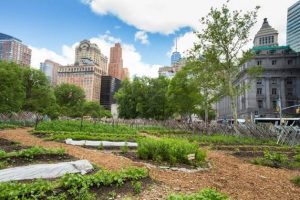
Urban Farm gardening project in New York City. Urban agriculture is a sustainable way of growing food and local economies and meeting food security needs for urban dwellers. Credit: Shutterstock
By Ifeanyi Nsofor and Esther Ngumbi
SILVER SPRING, Maryland / URBANA, Illinois, USA, Feb 15 2024 – Recently, a group of non-profit organizations launched the Inaugural Souper Bowl of Caring – a nationwide movement to address hunger-related challenges. It was an opportunity for VIP guests to engage and lend their support to end food insecurity as part of the Super Bowl. The goal is to encourage every viewer of the Super Bowl to contribute $1 or one can of soup.
Initiatives such as the one launched by NGOs are important since they tackle a pressing challenge: ending food insecurity in the US.
Urban agriculture leads to efficient utilization of unused urban spaces such as empty parking lots, rooftops, and vacant plots of land. Such spaces can be used to grow a range of crops, including tomatoes, potatoes, lettuces, carrots, herbs, and even edible flowers
Currently, over 10% of Americans are food insecure. But while donations can help in the short-term, they need to be accompanied with other long-term solutions. Among the long-term solutions that Super Bowl 2024 VIPs, investors, companies that spent $7 million for 30-second spots of commercial time, and viewers can do is to invest in and support urban agriculture and urban farmers.
Why are urban farms worthy of this attention?
Urban agriculture is a sustainable way of growing food and local economies and meeting food security needs for urban dwellers. On the global level, 15% – 20% of the world’s food supply is sourced from urban areas. Urban farming is growing across many U.S. cities too – from Chicago to Urbana to Kansas to Washington DC to Minneapolis to Atlanta to New York to Los Angeles to Las Vegas where the 2024 Super Bowl championship is taking place.
Urban agriculture leads to efficient utilization of unused urban spaces such as empty parking lots, rooftops, and vacant plots of land. Such spaces can be used to grow a range of crops, including tomatoes, potatoes, lettuces, carrots, herbs, and even edible flowers. Growing crops within urban centers makes them close to markets and it becomes easy for urban farm produce to be transported to markets. It is also seamless for urban residents to walk to urban farms and buy directly from the source. The proximity of foods to markets considerably contributes to fewer emissions and helps mitigate the impacts of climate change.
Urban agriculture can bring about several social, cultural and community benefits. For example, urban farms can serve as a community space, where different events including workshops, training, farm to dinner, you pick, and weddings happen.
They can help create food secure and resilient urban communities and serve as lifelines for urban dwelling citizens when the food supply chain is disrupted by weather events, pandemics such as covid19, cyber security attacks or plant diseases and pests outbreaks.
In the United States, urban farms can build up the workforce. By venturing into urban farming, communities build their local economies and provide job opportunities for people living in those communities. City Councils can support the creation of urban food hubs.
An example is the University of the District of Columbia food hubs located in food desert neighborhoods of Washington, D.C. Food hubs comprise of food production, food preparation, food distribution, and waste and water recovery. These processes contribute to increasing the workforce in cities and overall economic growth.
Of course, urban farming cannot beat rural agriculture, nor take its place. But it offers an important way for people living in urban areas to gain access to local, fresh and culturally relevant foods.
Further, urban farming comes with its challenges. Soils in urban regions are particularly contaminated with heavy metals such as lead, arsenic, and copper. For example, Chicago’s soil lead concentrations are high.
Therefore, it is imperative to pay attention to the land’s history, especially soil history. Furthermore, a new study found that food from urban agriculture has a carbon footprint six times larger than conventionally grown produce. To mitigate this, urban agriculture practitioners can cultivate crops that are typically greenhouse-grown or air-freighted, in addition to making changes in site design and management.
Ultimately, there are economic, environmental, and social benefits that accrue from urban farming. The Super Bowl, with its huge viewership, could be an important platform to support urban farmers.
In preparation for the 2025 Super Bowl, Americans should consider contributing to the ‘Super Bowl of Caring’. Moving forward, it would be great to see urban farms take the center stage at the Super Bowl.
Dr. Ifeanyi M. Nsofor, MBBS, MCommH (Liverpool) is Senior New Voices Fellow at the Aspen Institute, Senior Atlantic Fellow for Health Equity at George Washington University, 2006 Ford Foundation International Fellow.
Esther Ngumbi, PhD is Assistant Professor, Department of Entomology, African American Studies Department, University of Illinois at Urbana-Champaign